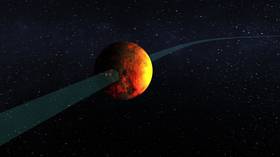Astronomers discover enormous exoplanet with wild, slingshot-like orbit

Astronomers have discovered a gigantic exoplanet with a truly bizarre and extreme orbit that flings it around its star like a slingshot.
Exoplanet HR 5183-b doesn’t have the usual circular orbit that most planets have. Instead, the planet, which has three times the mass of Jupiter, has a long, oval orbit and slingshots around in a manner that is more like a comet, exciting new research from Caltech astronomers has found.
“This planet is unlike the planets in our Solar System, but more than that, it is unlike any other exoplanets we have discovered so far,”said study lead author Sarah Blunt.
Also on rt.com Newly discovered exoplanet is contender for human colonizationOther planets that are far away from their stars usually have more circular orbits. “The fact that this planet has such a high eccentricity speaks to some difference in the way that it either formed or evolved relative to the other planets,” Blunt said.
HR 5183-b orbits HR 5183 and each orbit takes about 74 years to complete, with the exoplanet traveling as far out as 30 astronomical units.
“This planet spends most of its time loitering in the outer part of its star’s planetary system in this highly eccentric orbit, then it starts to accelerate in and does a slingshot around its star,” Caltech astronomer Andrew Howard explained.
The planet’s star was under long term surveillance as part of an exoplanet search. Its unusual and very long orbit makes it difficult to detect, but scientists were able to capture it when it was at periastron, its closest approach at less than five astronomical units.
Also on rt.com A black hole so big it shouldn’t even exist is baffling scientistsComets can change orbital paths when they come into gravitational contact with larger Solar System bodies, and researchers think something similar may have happened to HR 5183-b. It may have been close to another planet of similar size and, when the two planets got close enough, a gravitational interaction may have set HR 5183-b off on its new, stranger orbit and seen the other planet pushed out of the system altogether.
“This newfound planet is another example of a system that is not the image of our Solar System but has remarkable features that make our Universe incredibly rich in its diversity,” Howard said.
Think your friends would be interested? Share this story!














